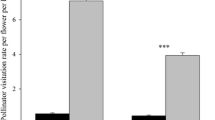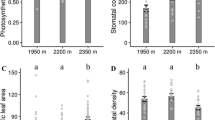Abstract
Plant populations often exist in spatially heterogeneous environments. Light level can directly affect plant reproductive success through resource availability or by altering pollinator behavior. It can also indirectly influence reproductive success by determining floral display size which may in turn influence pollinator attraction. We evaluated direct and indirect effects of light availability and measured phenotypic selection on phenological traits that may enhance pollen receipt in the insect-pollinated herb Campanulastrum americanum. In a natural population, plants in the sun had larger displays and received 7 times more visits than plants in the shade. Using experimental arrays to separate the direct effects of irradiance on insects from their response to display size, we found more visits to plants in the sun than in the shade, but no association between number of visits each flower received and display size. Plants in the sun were not pollen limited but pollen-augmented shade flowers produced 50% more seeds than open-pollinated flowers. Phenological traits, which may influence pollen receipt, were not under direct selection in the sun. However, earlier initiation and a longer duration of flowering were favored in the shade, which may enhance visitation in this pollen-limited habitat.




Similar content being viewed by others
References
Abe T (2001) Flowering phenology, display size, and fruit set in understory dioecious shrub, Acuba japonica (Cornaceae). Am J Bot 88:455–461
Andersson S (1991) Floral display and pollination success in Achillea ptarmica (Asteraceae). Holarctic Ecol 14:186–191
Ashman TL, Morgan MT (2004) Explaining phenotypic selection on plant attractive characters: male function, gender balance or ecological context? Proc R Soc Lond B 271:553–559
Ashman TL, Knight TM, Steets JA, Amarasekare P, Burd M, Campbell DA, Dudash MR, Johnston MO, Mazer SJ, Mitchell RJ, Morgan MT, Wilson WG (2004) Pollen limitation of plant reproduction: ecological and evolutionary causes and consequences. Ecology 85:2408–2421
Bishop JA, Armbruster WS (1999) Thermoregulatory abilities of Alaskan bees: effects of size, phylogeny and ecology. Funct Ecol 13:711–724
Bloom AJ, Chapin III FS, Mooney HA (1985) Resource limitation in plants—an economic analogy. Annu Rev Ecol Syst 16:363–392
Bond WJ (1994) Do mutualisms matter? Assessing the impact of pollinator and disperser disruption on plant extinction. Phil Trans R Soc Lond B 344:83–90
Brody AK (1997) Effects of pollinators, herbivores, and seed predators on flowering phenology. Ecology 78:1624–1631
Burgess KS, Etterson JR, Galloway LF (2007) Artificial selection shifts flowering phenology and other correlated traits in an autotetraploid herb. Heredity 99:641–648
Caruso CM (2000) Competition for pollination influences selection on floral traits of Ipomopsis aggregata. Evolution 54:1546–1557
Comba L (1999) Patch use by bumblebees (Hymenoptera apidae): temperature, wind, flower density and traplining. Ethol Ecol Evol 11:243–264
Conner JK, Rush S (1996) Effects of flower size and number on pollinator visitation to wild radish, Raphanus raphanistrum. Oecologia 105:509–516
Domínguez CA, Dirzo R (1995) Rainfall and flowering synchrony in a tropical shrub: variable selection on the flowering time of Erythroxylum havanense. Evol Ecol 9:204–216
Evanhoe L, Galloway LF (2002) Floral longevity in Campanula americana (Campanulaceae): a comparison of morphological and functional gender phases. Am J Bot 89:587–591
Farris MA (1988) Quantitative genetic variation and natural selection in Cleome serrulata growing along a mild soil moisture gradient. Can J Bot 66:1870–1876
Galloway LF (2005) Maternal effects provide phenotypic adaptation to local environmental conditions. New Phytol 166:93–100
Galloway LF, Cirigliano T, Gremski K (2002) The contribution of display size and dichogamy to potential geitonogamy in Campanula americana. Int J Plant Sci 163:133–139
Gleeson SK, Tilman D (1992) Plant allocation and the multiple limitation hypothesis. Am Nat 139:1322–1343
Grindeland JM, Sletvold N, Ims RA (2005) Effects of floral display size and plant density on pollinator visitation rate in a natural population of Digitalis purpurea. Funct Ecol 19:383–390
Groom MJ (1998) Allee effects limit population viability of an annual plant. Am Nat 151:487–496
Gross RS, Werner PA (1983) Relationships among flowering phenology, insect visitors, and seed-set of individuals: experimental studies on four co-occurring species of goldenrod (Solidago: Compositae). Ecol Monogr 53:95–117
Haggerty BP (2006) Responses to growing season length in the American bellflower, Campanulastrum americanum: implications for climate change. M.S. thesis, University of Virginia, Va.
Haig D, Westoby M (1988) On limits to seed production. Am Nat 131:757–759
Hansen V-I, Totland Ø (2006) Pollinator visitation, pollen limitation, and selection on flower size through female function in contrasting habitats within a population of Campanula persicifolia. Can J Bot 84:412–420
Heinrich B (1993) The hot-blooded insects, 1st edn. Harvard University Press, Cambridge, Mass.
Herrera CM (1995a) Floral biology, microclimate, and pollination by ectothermic bees in an early-blooming herb. Ecology 76:218–228
Herrera CM (1995b) Microclimate and individual variation in pollinators: flowering plants are more than their flowers. Ecology 76:1516–1524
Herrera CM (1997) Thermal biology and foraging responses of insect pollinators to the forest floor irradiance mosaic. Oikos 78:601–611
Kalisz S (1986) Variable selection on the timing of germination in Collinsia verna (Scrophulariaceae). Evolution 40:479–491
Kearns CA, Inouye DW, Waser NM (1998) Endangered mutualisms: the conservation of plant–pollinator interactions. Annu Rev Ecol Syst 29:83–112
Kelly CA (1992) Spatial and temporal variation in selection on correlated life-history traits and plant size in Chamaecrista fasiculata. Evolution 46:1658–1673
Lande R, Arnold SJ (1983) The measurement of selection on correlated characters. Evolution 37:1210–1226
Lechowicz MJ, Bell G (1991) The ecology and genetics of fitness in forest plants. II. Microspatial heterogeneity of the edaphic environment. J Ecol 79:687–696
Liow HL, Sodhi NS, Elmqvist T (2001) Bee diversity along a disturbance gradient in tropical lowland forests of south-east Asia. J Appl Ecol 38:180–192
Lloyd DG (1992) Self-fertilization and cross-fertilization in plant. II. The selection of self-fertilization. Int J Plant Sci 153:370–380
McConnaughay KDM, Coleman JS (1999) Biomass allocation in plants: ontogeny or optimality? A test along three resource gradients. Ecology 80:2581–2593
Moeller DA, Geber MA (2005) Ecological context of the evolution of self-pollination in Clarkia xantiana: population size, plant communities, and reproductive assurance. Evolution 59:786–799
Newmark WD (2001) Tanzanian forest edge microclimatic gradients: dynamic patterns. Biotropica 33:2–11
Rodriguez J, Jordano D, Haeger JF (1994) Spatial heterogeneity in a butterfly: host–plant interactions. J Anim Ecol 63:31–38
Stewart SC, Scoen DJ (1987) Pattern of phenotypic viability and fecundity selection in a natural population of Impatiens pallida. Evolution 41:1290–1301
SAS Institute (2005) SAS/STAT version 9.1. SAS Institute, Cary, N.C.
Totland Ø (2001) Environment-dependent pollen limitation and selection on floral traits in an alpine species. Ecology 82:2233–2244
Vanhoenacker D, Ågren J, Ehrlén J (2006) Spatio-temporal variation in pollen limitation and reproductive success of two scape morphs in Primula farinosa. New Phytol 169:615–621
Widén B (1991) Phenotypic selection on flowering phenology in Senecio intergrifolius, a perennial herb. Oikos 61:205–215
Wright JW, Meagher TR (2003) Pollination and seed predation drive flowering phenology in Silene latifolia (Caryophyllaceae). Ecology 84:2062–2073
Zimmerman M, Pyke GH (1988) Reproduction in Polemonium: assessing the factors limiting seed set. Am Nat 131:723–738
Acknowledgements
Thanks to Tim Kugler for work conducting array experiments, MLBS for logistical support, and NSF DBI-0453380 REU-sites for support to MLBS and DEB-0316298 to L. F. G. All experiments comply with the current laws of the United States of America.
Author information
Authors and Affiliations
Corresponding author
Additional information
Communicated by Louis Pitelka.
Rights and permissions
About this article
Cite this article
Kilkenny, F.F., Galloway, L.F. Reproductive success in varying light environments: direct and indirect effects of light on plants and pollinators . Oecologia 155, 247–255 (2008). https://doi.org/10.1007/s00442-007-0903-z
Received:
Revised:
Accepted:
Published:
Issue Date:
DOI: https://doi.org/10.1007/s00442-007-0903-z




